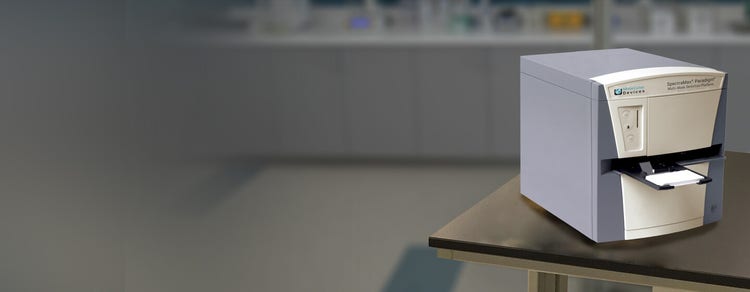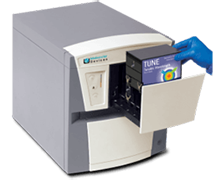

SpectraMax Paradigm Multi-Mode Microplate Reader
High-throughput screening capability on one fast, configurable microplate reader
Z-height and microplate optimization increases assay dynamic range and sensitivity
The SpectraMax® Paradigm® Multi-Mode Microplate Reader measures absorbance, fluorescence, time-resolved fluorescence (including HTRF), fluorescence polarization, AlphaScreen®, AlphaLISA®, and luminescence assays for up to 1536-well plates. Detection cartridge modularity allows for easy addition of new read modes within minutes without requiring a service visit, while providing the flexibility for future applications.

Get automatic Z-height optimization
Z-height focusing is enabled for fast top- and bottom-reads for all read modes. By performing Z-height optimization, a lens is adjusted to address low volumes or varied well geometry.

Eliminate manual gain adjustment
The detection cartridge utilizes an energy intensity optimization technique allowing you to read up to seven logs of sample concentration in a single pass of a plate without manual gain adjustment.

Tailor your data analysis
Perform multiple calculations on one data set, compare multiple experiments side-by-side, and adjust reduction parameters while collecting real-time data with SoftMax® Pro Software.
Features

Configuration changes in minutes
Adding new read modes is fast and simple with the detection cartridge system. Order additional detection cartridges as your application needs change, and install them by yourself in under two minutes.

Increased dynamic range and sensitivity
Use predefined reductions, columns, and summary formulas, or create custom calculations. Analyze EC50 and Z-factors to identify assay quality, and graph results with over 21 curve fit options.
Latest Resources
Featured Applications
Customer Breakthrough
Applications of SpectraMax Paradigm Multi-Mode Microplate Reader
Specifications & Options of SpectraMax Paradigm Multi-Mode Microplate Reader
*Using lowest settings and speed read when available.
Download Data Sheet

Resources of SpectraMax Paradigm Multi-Mode Microplate Reader
SpectraMax® Paradigm Multi-Mode Microplate Reader
Multi-Mode Validation Plate for SpectraMax® Paradigm
& FilterMax™ F3/F5 Systems